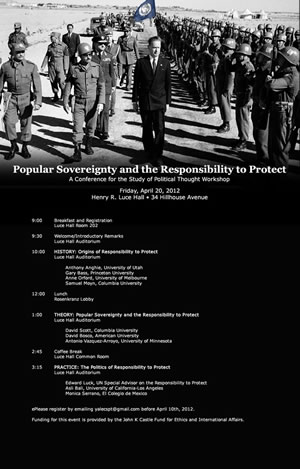
At the beginning of the academic year, the International Conference for the Study of Political Thought, an organization of political theorists, moved its headquarters to Yale University, where Political Science faculty members Bryan Garsten and Karuna Mantena serve as the organization’s new co-chairs. CSPT was started in Toronto and New York in 1967 by a number of political theorists who wanted to preserve and encourage a broad, humanistic style of thinking about politics. CSPT’s founding documents stated the organization’s purpose in the following terms: “The members of the Conference hold that this humanist style is an integral part of the disciplines treating politics; that it has more power than any other to engage thinking men in rational dialogue about the ends of politics and the means permissible for their attainment; that those trained without knowledge of this tradition are incomplete as men, citizens, and political analysts; and that the study of politics, if reduced to a science of behavior, leaves to the demagogues and ideologues that all-important area where ethics and politics converge in the discussion of purposes and goals.” Currently, CSPT has 19 chapters in the United States and 11 chapters abroad. During their tenure as co-chairs, Professor Garsten and Professor Mantena hope to emphasize the international dimensions of CSPT, while also using CSPT sponsored conferences and workshops to draw attention to the relevance of theories and ideas to contemporary political issues.
Both of these aims informed CSPT’s first workshop at Yale on “Popular Sovereignty and the Responsibility to Protect” held on April 20 at Luce Hall. Over the last two decades, the international norm of responsibility to protect (or R2P) has transformed the meaning of sovereignty and provided justifications for international interventions in instances where states have failed to protect citizens. This concept was articulated and developed in the aftermath of NATO’s military action in Kosovo by the International Commission on Intervention and State Sovereignty in 2001 and at the 2005 World Summit. Last year’s intervention in Libya was the first in which R2P was evoked to justify international action. The recent discussions about violence in Syria have also included debates about whether R2P is applicable.
Bringing together an interdisciplinary group of international lawyers, political theorists, policy makers, and historians, the CSPT workshop closely considered the history of R2P, and its relationship to prior conceptions and justifications of international intervention; the theory of responsibility and how it interacts with ideas of sovereignty and popular sovereignty; and the practice of R2P in contemporary international politics. With its interdisciplinary orientation and contemporary relevance, the workshop attracted faculty and students from the Law School, and the Jackson Institute, as well as the Departments of History and Political Science. A student from New York University and another from Boston College also attended the conference.
Panelists offered competing ways of understanding the novelty and significance of R2P. For example, in the history panel, Antony Anghie of the University of Utah Law School situated R2P in a long, historical trajectory, where the concepts of responsibility and protection are entangled in the very conception of Westphalian sovereignty and politics of early modern European expansion. Melbourne Law School professor Anne Orford, and Samuel Moyn, a historian at Columbia University, emphasized the mid-20th century crises of decolonization in their accounts of the origins of R2P and suggested that the post-colonial world raised new questions of international governance to which R2P is a response. Similar differences emerged in the panel on the practice of R2P. Edward Luck, United Nations Special Advisor on the Responsibility to Protect, provided an eye-opening account of how United Nations advisors and member countries have elaborated R2P conceptually and in practice. Focusing on the recent intervention in Libya, Aslı Bâli, Professor of Law at UCLA, pointed out the importance of being attentive to the means deployed in the name of protection. Monica Serrano, Professor of International Relations at Colegio de México, argued against the mobilization of R2P in the aftermath of a political or a humanitarian crisis, and urged participants to consider how R2P might be deployed to prevent and preempt these crises.
Far from speaking past each other, these alternative accounts illustrated the complex theoretical and political questions R2P raises. Moreover, the conversations at the workshop – both during the panels and during meals and coffee breaks – exemplified the promise of interdisciplinary exchange. The combination of historical, legal and theoretical insights offered by the panelists and participants do not provide singular narratives and easy answers, but instead open up new areas of investigation and inquiry. For political theorists in particular, such exchanges are important because they invite the discipline to reconsider sovereignty, one of the central organizing concepts of political thought. As Professor Mantena suggested in her opening remarks, there is a tendency in the field to dwell on the isolated nation-state and examine the domestic face of sovereignty. For scholars of international relations and international law, the opposite might be said. In those fields, much of the discussion of sovereignty emphasizes its significance as a feature of the global political system without sustained attention on the domestic arrangements of sovereignty. By bringing these perspectives together, scholars of political theory are asked to take up the external face of sovereignty in a more sustained fashion, while scholars of international politics are invited to consider the relevance of questions such as legitimacy and authority within the domestic face of sovereignty. This spirit of critical dialogue and exchange was at the heart of CSPT’s founding in the 1960s and will remain a guidepost during the organization’s time at Yale.
